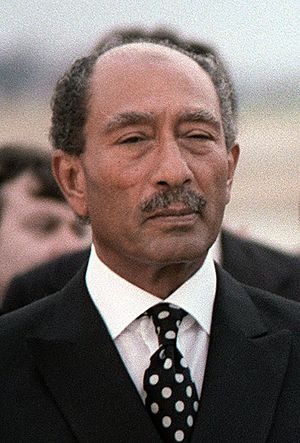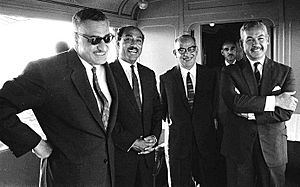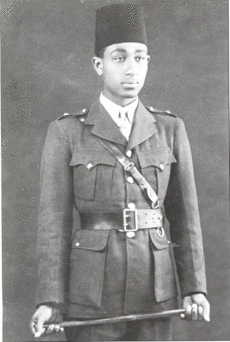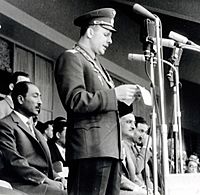Anwar Sadat facts for kids
Quick facts for kids
Anwar Sadat
|
|
|---|---|
| أنور السادات | |

Sadat in 1980
|
|
| 3rd President of Egypt | |
| In office 15 October 1970 – 6 October 1981 Acting: 28 September 1970 – 15 October 1970 |
|
| Prime Minister |
See list
|
| Vice President |
See list
|
| Preceded by | Gamal Abdel Nasser |
| Succeeded by | Sufi Abu Taleb (Acting) Hosni Mubarak |
| 37th Prime Minister of Egypt | |
| In office 15 May 1980 – 6 October 1981 |
|
| President | Himself |
| Preceded by | Mustafa Khalil |
| Succeeded by | Hosni Mubarak |
| In office 26 March 1973 – 25 September 1974 |
|
| President | Himself |
| Preceded by | Aziz Sedki |
| Succeeded by | Abd El Aziz Muhammad Hegazi |
| Vice President of Egypt | |
| In office 19 December 1969 – 14 October 1970 |
|
| President | Gamal Abdel Nasser |
| Preceded by | Hussein el-Shafei |
| Succeeded by | Ali Sabri |
| In office 17 February 1964 – 26 March 1964 |
|
| President | Gamal Abdel Nasser |
| Preceded by | Hussein el-Shafei |
| Succeeded by | Zakaria Mohieddin |
| Speaker of the National Assembly of Egypt | |
| In office 21 July 1960 – 20 January 1969 |
|
| President | Gamal Abdel Nasser |
| Preceded by | Abdel Latif Boghdadi |
| Succeeded by | Mohamed Labib Skokeir |
| Personal details | |
| Born |
Muhammad Anwar el-Sadat
محمد أنور السادات 25 December 1918 Monufia, Sultanate of Egypt |
| Died | 6 October 1981 (aged 62) Cairo, Egypt |
| Cause of death | Assassination |
| Resting place | Unknown Soldier Memorial |
| Political party | National Democratic Party |
| Other political affiliations |
Arab Socialist Union |
| Spouses |
|
| Children | 7 |
| Alma mater | University of Alexandria |
| Signature |  |
| Military service | |
| Allegiance | Egypt |
| Branch/service | |
| Years of service | 1938–1952 |
| Rank | |
Muhammad Anwar el-Sadat (born 25 December 1918 – died 6 October 1981) was an Egyptian leader and soldier. He served as the third President of Egypt from 1970 until he was killed in 1981.
Sadat was an important member of the Free Officers. This group helped remove King Farouk from power in the Egyptian Revolution of 1952. He was also a close friend of President Gamal Abdel Nasser. Sadat served as Vice President twice under Nasser and became president after Nasser passed away in 1970.
In 1978, Sadat and Menachem Begin, who was the Prime Minister of Israel, signed a peace treaty. They worked with United States President Jimmy Carter. For their efforts, they both received the Nobel Peace Prize. Sadat was the first Muslim person to win a Nobel Prize.
During his eleven years as president, Sadat changed Egypt a lot. He moved away from many of Nasser's old ideas about politics and the economy. He brought back a system where many political parties could exist. He also started a new economic plan called Infitah, which means "opening up."
As president, he led Egypt in the Yom Kippur War in 1973. The goal was to get back Egypt's Sinai Peninsula, which Israel had taken in 1967. This made him a hero in Egypt and the wider Arab World for a while. After the war, he started talking with Israel to make peace. This led to the Egypt–Israel peace treaty. This treaty gave the Sinai back to Egypt.
Most Egyptians liked the peace treaty. However, some groups, like the Muslim Brotherhood, felt Sadat had given up on helping create a Palestinian state. Most Arab countries and the Palestine Liberation Organization (PLO) strongly disagreed with Sadat making peace with Israel on his own. Because he would not agree with them on the Palestinian issue, Egypt was suspended from the Arab League from 1979 to 1989. The peace treaty was also a main reason for his assassination. On 6 October 1981, soldiers led by Khalid Islambouli shot Sadat during a parade in Cairo, and he died.
Contents
Anwar Sadat's Early Life and Revolutionary Actions
Anwar Sadat was born on 25 December 1918. He came from a poor family in Mit Abu El Kom, which was part of the Sultanate of Egypt. He had 12 brothers and sisters. One of his brothers, Atef Sadat, became a pilot and died fighting in the 1973 war.
He finished school at the Royal Military Academy in Cairo in 1938. He joined the army as a second lieutenant. He was sent to Anglo-Egyptian Sudan, which was controlled by both Britain and Egypt at the time. There, he met Gamal Abdel Nasser. They, along with other young officers, formed a secret group called the Free Officers. Their goal was to remove the British from Egypt and stop corruption in the royal family.
During World War II, the British put Sadat in prison. This was because he tried to get help from the Axis Powers to make the British leave Egypt. After the war, he was involved in political activities. He joined different groups, including the Muslim Brotherhood.
Sadat and his fellow Free Officers took part in the military coup that started the Egyptian Revolution of 1952. This event removed King Farouk from power on 23 July 1952. Sadat was chosen to announce the news of the revolution to the people of Egypt on the radio.
Anwar Sadat as Vice President

When Gamal Abdel Nasser was president, Sadat was made a minister in 1954. He also became the editor of a new newspaper called Al Gomhuria. In 1959, he became the Secretary of the National Union.
Sadat was the President of the National Assembly from 1960 to 1968. Then, in 1964, he became vice president and a member of the presidential council. He was made vice president again in December 1969.
Anwar Sadat's Presidency
Sadat became president after Nasser died in October 1970. Many people thought Sadat would not be president for long. They believed he would be easy for Nasser's supporters to control. But Sadat surprised everyone. He made smart political moves that helped him stay president and become a strong leader on his own.
On 15 May 1971, Sadat announced his Corrective Revolution. This meant he removed many of Nasser's strongest supporters from the government and security groups. Sadat also allowed an Islamist movement to grow, which Nasser had stopped. He thought these groups would help him politically.
In 1971, Sadat supported peace ideas from the UN. These ideas suggested full peace with Israel if Israel moved back to its borders from before the war. This peace plan did not work because neither Israel nor the United States agreed to the terms at that time.
Sadat's Corrective Revolution
Soon after becoming president, Sadat surprised many Egyptians. He removed and put in prison two very powerful people: Vice President Ali Sabri and Interior Minister Sharawy Gomaa. Sabri was close to Soviet officials, and Gomaa controlled the secret police.
Sadat became more popular when he reduced the power of the secret police. He also sent Soviet military members out of the country. He then worked to make the Egyptian army stronger for another fight with Israel.
The Yom Kippur War
On 6 October 1973, Sadat worked with Hafez al-Assad of Syria to start the Yom Kippur War. This was a surprise attack against Israeli forces. Israel had taken the Egyptian Sinai Peninsula and the Syrian Golan Heights in 1967. Egypt and Syria wanted to get these lands back.
Egypt and Syria did very well at the start of the war. This surprised both Israel and the Arab World. Egypt's army crossed the Suez Canal and broke through the Bar Lev Line. This line was thought to be impossible to break.
Later in the war, Israeli forces crossed the Suez Canal. The United Nations Security Council called for a ceasefire on 22 October 1973. Even though both sides agreed, the fighting continued. The Israeli army then surrounded the Egyptian army. A second ceasefire was put in place on 25 October to end the war.
Making Peace with Israel


The early victories by Egypt and Syria in the war made people in Egypt and the Arab World feel proud. For many years, Sadat was called the "Hero of the Crossing." Israel saw Egypt as a strong opponent. Egypt's new importance in politics eventually led to getting back and reopening the Suez Canal through peace talks.
Sadat's new peace plan led to two agreements with Israel. These agreements helped separate the forces. The first was signed on 18 January 1974, and the second on 4 September 1975.
Sadat also wanted religious support for his peace efforts. He invited American pastor Billy Graham to visit Egypt. He also worked with the Vatican. In 1976, he visited the Vatican and got support from Pope Paul VI for peace with Israel.
In January 1977, there were protests in Egypt called the 1977 Egyptian Bread Riots. People were upset about Sadat's economic changes, especially when the government removed price controls on basic foods like bread. The protests lasted two days, and many buildings were damaged in Cairo. The army had to step in, and the government brought back the price controls.
On 19 November 1977, Sadat became the first Arab leader to officially visit Israel. He met with Israeli Prime Minister Menachem Begin and spoke to the Knesset (Israel's parliament) in Jerusalem. He talked about his ideas for peace in the Arab–Israeli conflict.
The peace treaty was finally signed by Anwar Sadat and Menachem Begin in Washington, D.C., USA, on 26 March 1979. This happened after the Camp David Accords in 1978. These were meetings between Egypt and Israel arranged by US President Jimmy Carter. Both Sadat and Begin won the Nobel Peace Prize for making the treaty.
The main parts of the agreement were:
- Both countries recognized each other.
- The state of war that had existed since 1948 ended.
- Israel completely removed its armed forces and people from the rest of the Sinai Peninsula. Israel had taken this land during the 1967 Six-Day War.
The agreement also said that Israeli ships could pass freely through the Suez Canal. It also recognized the Strait of Tiran and the Gulf of Aqaba as international waterways. Egypt became the first Arab country to officially recognize Israel. The peace agreement between Egypt and Israel is still in effect today.
Most of the Arab World and Muslim World did not like the treaty. Many Arab countries felt Sadat had put Egypt's interests first, instead of Arab unity. They thought he had betrayed the idea of a united "Arab front" to support Palestinians against Israel. However, Sadat decided early on that peace was the best solution.
In 1979, the Arab League suspended Egypt because of the peace agreement with Israel. The League moved its main office from Cairo to Tunis. It was not until 1989 that Egypt was allowed back into the Arab League, and its headquarters returned to Cairo.
As part of the peace deal, Israel slowly left the Sinai Peninsula. They finished leaving almost all the land by 25 April 1982. The better relations Egypt gained with Western countries through the Camp David Accords helped Egypt's economy grow.
Sadat's Relationship with the Shah of Iran
The relationship between Iran and Egypt was not good during Gamal Abdel Nasser's time. But after Nasser died in 1970, President Sadat quickly changed this into a close friendship.
In 1971, Sadat spoke to the Iranian parliament in Tehran in fluent Persian. He talked about the long history between the two countries. The governments of Egypt and Iran quickly became good friends. The Shah of Iran, Mohammad Reza Pahlavi, even called Sadat his "dear brother."
After the 1973 war with Israel, Iran helped a lot in cleaning up and reopening the Suez Canal. Iran also helped Israel leave the occupied Sinai Peninsula. They promised to give Israel free Iranian oil if they left the Egyptian oil wells. All these actions made the personal friendship between Sadat and the Shah even stronger.
After he was removed from power, the Shah spent his last months living in Egypt. When the Shah died, Sadat ordered a state funeral for him. The Shah was buried in the Al-Rifa'i Mosque in Cairo, where other Egyptian royal family members are buried.
Anwar Sadat's Assassination
The last few months of Sadat's time as president saw some unrest inside Egypt. Sadat believed that the Soviet Union was encouraging other countries to cause trouble in Egypt. He thought they wanted to force him out of power. After a failed military coup in June 1981, Sadat ordered many opposition figures to be arrested.
Earlier in his presidency, Sadat had released some Islamist activists from prison. But his peace treaty with Israel made many Islamists very angry, especially a group called Egyptian Islamic Jihad. This group was gathering weapons and planning to overthrow the government. Their plan was to kill the country's main leaders and take over important buildings like army headquarters and the radio station. They hoped this would start a popular uprising.
In February 1981, Egyptian authorities learned about the group's plan. In September, Sadat ordered the arrest of more than 1,500 people. This included many members of the Jihad group, but also the Coptic Pope and other religious leaders, thinkers, and activists. All non-government newspapers were also banned. However, a Jihad group in the military, led by Lieutenant Khalid Islambouli, was not caught. This group succeeded in killing Anwar Sadat that October.
On 6 October 1981, Sadat was killed during the yearly victory parade in Cairo. This parade celebrated Egypt's crossing of the Suez Canal in the 1973 war. Islambouli shot Sadat with an automatic rifle while Sadat was in front of the main viewing stand. Sadat was badly wounded and died. Eleven other people were also killed, including the Cuban ambassador and an Omani general. Twenty-eight people were wounded, including Vice President Hosni Mubarak.
The group that killed Sadat was led by Lieutenant Khalid Islambouli. He had received a religious ruling (a fatwā) that approved the assassination. Islambouli was put on trial, found guilty, and executed by firing squad in April 1982.
After Sadat's Death
Sadat was replaced by his vice president, Hosni Mubarak. Mubarak was injured in the attack. Many important people from around the world attended Sadat's funeral. Three former US presidents – Gerald Ford, Jimmy Carter, and Richard Nixon – were there. Sudan's President Gaafar Nimeiry was the only Arab head of state to attend. Only 3 out of 24 countries in the Arab League sent representatives. Israel's prime minister, Menachem Begin, thought of Sadat as a personal friend and made sure to attend the funeral. Sadat was buried in the unknown soldier memorial in Cairo, right across the street from where he was killed.
More than three hundred Islamic radicals were charged in connection with the assassination. This included future al-Qaeda leader Ayman al-Zawahiri.
Anwar Sadat in Media
In 1983, a TV miniseries called Sadat was made about his life. It starred Louis Gossett Jr. as Sadat. The Egyptian government quickly banned the film and all other movies from the company that made it. They said the film was not historically accurate.
The first Egyptian movie about Sadat's life was Ayyam El Sadat (English: Days of Sadat), released in 2001. This movie was very popular in Egypt.
Young Sadat is also an important character in Ken Follett's book The Key to Rebecca. This story takes place in Cairo during World War II. Sadat is shown as a young officer in the Egyptian Army who is against the British. He works with German spies because he wants allies to help remove the British from his country.
Honours and Awards
From Egypt
- Collar of the Order of the Republic
- Grand Cordon of the Order of the Nile
- Grand Cross of the Order of Merit
- Supreme Class of the Order of the Virtues
From Other Countries
- Albania: Grand Cross of the Order of Fidelity
- Austria: Grand Star of the Order of Honour for Services to the Republic of Austria
- Italy: Knight Grand Cross of the Order of Merit of the Italian Republic
- Kuwait: Collar of the Order of Mubarak the Great
- Malaysia: Honorary Grand Commander of the Order of the Defender of the Realm (SMN (K)) – Tun (1965)
- Nepal: Member First Class of the Order of the Star of Nepal
- Nepal: Member of the Order of the Benevolent Ruler
- Saudi Arabia: Recipient of the Order of King Abdulaziz, 1st class
- Syria: Member First Class of the Order of the Umayyads
- Tunisia: Recipient of the Order of the Republic
- United States: Recipient of the Presidential Medal of Freedom (1984)
- United States: Recipient of the Congressional Gold Medal (2018, posthumous)
See Also
 In Spanish: Anwar el-Sadat para niños
In Spanish: Anwar el-Sadat para niños
Images for kids





